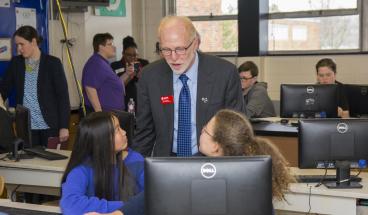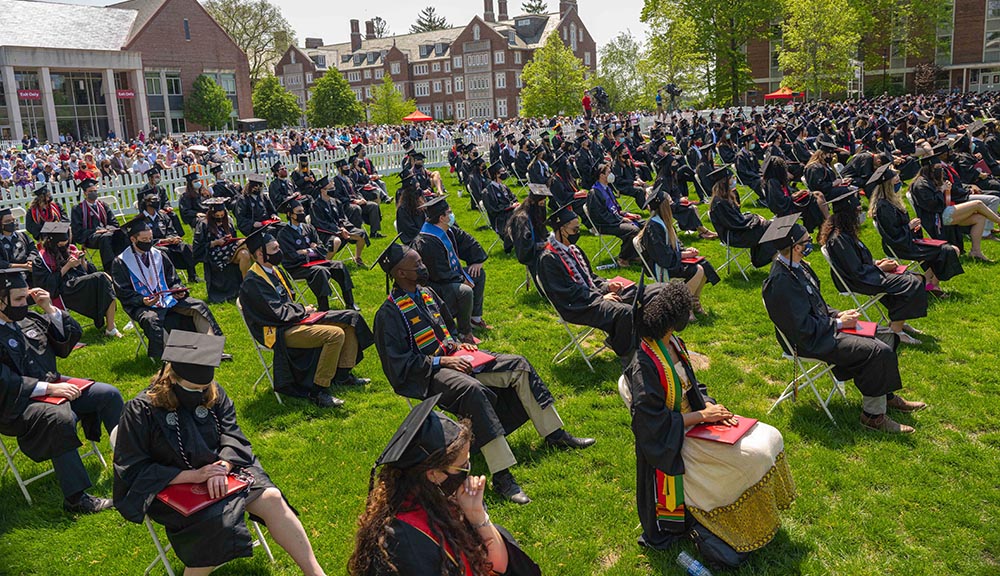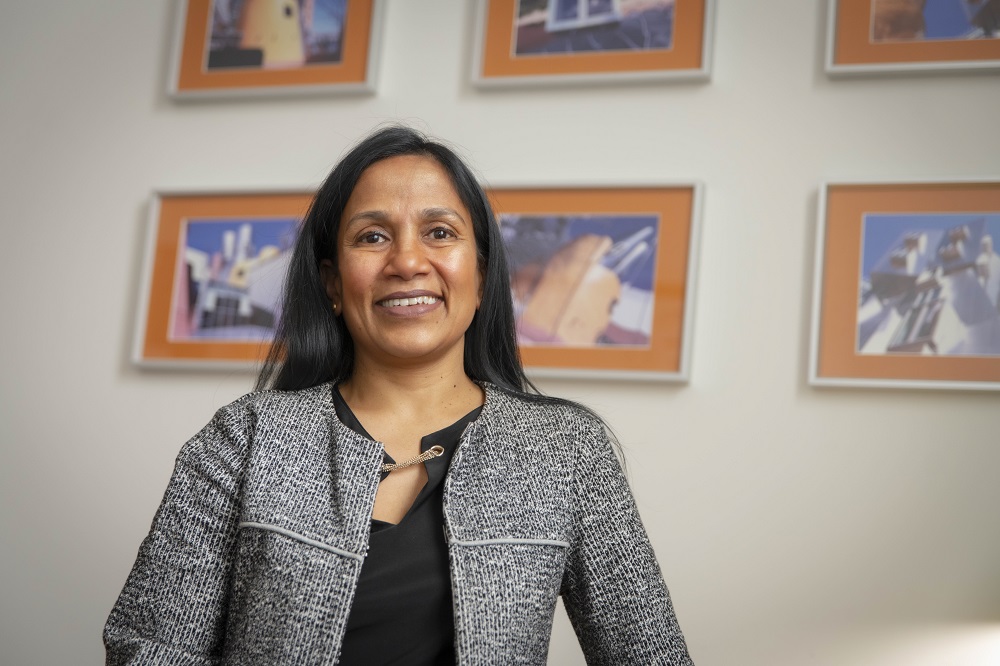Doherty Memorial High School freshman Katrina Sodano is just one of many students who will benefit from the infusion of grant money that Lt. Gov. Karyn Polito announced at the school on Wednesday in support of STEM education in Massachusetts. But if one student is any indication, the workforce will gain abundantly from the investment.
Working on a CAD-based button-making program in Doherty’s Engineering and Technology Academy, Sodano’s enthusiasm for the process touches briefly on her anticipation about someday using the 3-D printer (a privilege generally reserved for seniors), but then lands solidly well past her high school career.
“I think I might want to do this at a place like WPI,” she says. “In biomedical engineering you can use this to help people who are born without limbs. Or you can even use it in building bridges. You can do so much. It’s very exciting.”
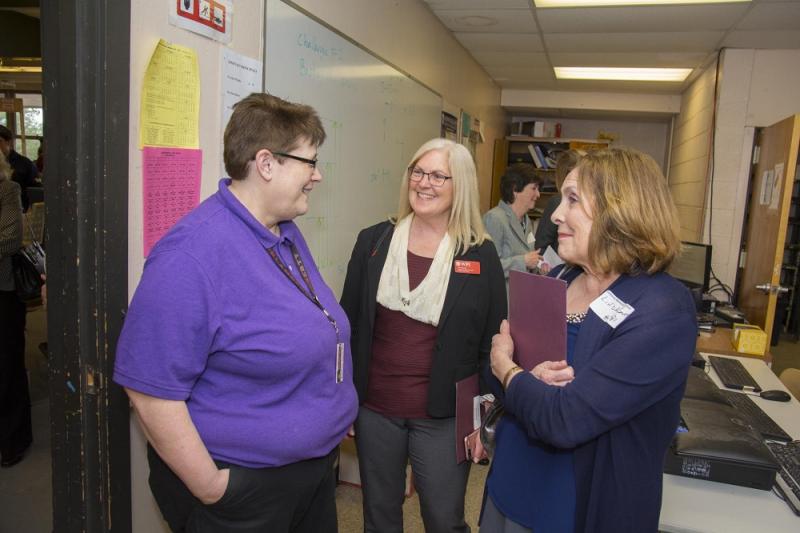
Doherty Memorial High teacher Annette Cochran speaks
with Martha Cyr and Linda Looft, WPI assistant vice
president for government and community relations.
Polito said a $750,000 STEM High Quality Career Pathways Capacity Grant from the state and a matching $300,000 grant from the philanthropic organization One8 Foundation will support STEM education through the combined partnership of WPI, Project Lead The Way (PLTW), and the One8 Foundation’s Mass STEM Hub. These grants will provide schools with the resources, equipment, curriculum, and teacher professional development to give students hands-on skills in STEM fields and fill a growing need for a diverse, skilled workforce.
Since 2004, WPI and Project Lead The Way have partnered on enhancing, advancing, and supporting STEM education. PLTW offers K-12 STEM curriculum based on real-world, applied learning and that’s led by trained educators. The program teaches a curriculum that both readies students for life after graduation, and prepares them for a productive experience as an employee, no matter where they are.
Students gain classroom knowledge and, through direct experiential learning, solve the kind of complex problems typically found in a work setting. Through clear communication, critical thinking, and creative solutions, they discover exactly how their classroom learning can be used with success.
But learning like this takes an approach slightly different from a classic lecture format. As an affiliate partner of Project Lead the Way since 2004, WPI has hosted PLTW’s intensive Summer Core Training professional development program for educators. Teachers come to campus to learn how to lead a classroom while being involved and invested in the discovery process.
This infusion of grant money opens opportunities for what students can learn and gives more schools access to the curriculum, but it also gives teachers the necessary training and support to learn a new way of teaching, says Martha Cyr, WPI’s executive director, STEM Education Center. “Our role is to support educators,” she says. “With this dramatic growth in particular students, teachers, and schools, we'll have a support network for teachers. It’s extremely important.”
As teachers begin the process of teaching students in a way that is often as new for them as it is for their students, many feel like they are operating in isolation, says Cyr. WPI will help expand the existing network of teachers and provide chances for them to gather and share information and experiences. The new grants allow WPI to offer new advanced training opportunities and to develop a larger group of mentor teachers to support the schools.
For teachers and administrators, seeing more support for the courses and programs they know will help kids land productive, interesting, and well-paying jobs is exciting. “Project Lead the Way is an educator’s dream,” said Worcester superintendent of schools Maureen Binienda. Giving students opportunities to apply their knowledge in class or through an internship, to develop essential critical thinking, and to work with teachers who are passionate about STEM is an excellent base from which to launch into the world.
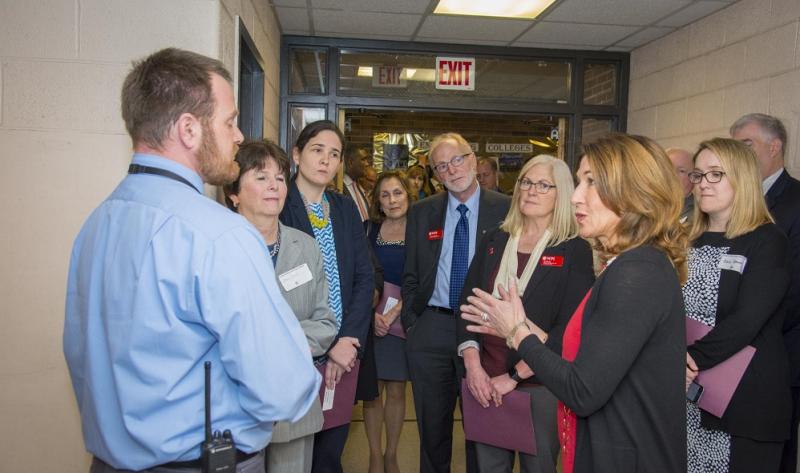
Linda Looft, Bruce Bursten and Martha Cyr, center, listen
as Lt. Gov. Karyn Polito speaks with John Staley, chair,
science and engineering at Doherty.
According to Mary Laturnau, PLTW's director of school engagement, the grants open doors for schools that might not have the budget for this kind of multifaceted, multilayered program. “Educators say this is the hardest and best thing,” she says—walking into a classroom and not being able to immediately identify the teacher is exactly what is needed for students to adapt and learn. But that doesn’t mean it’s easy for teachers to reach that point. “It’s a big switch,” she notes.
Noting the lifelong impact teachers have on students, Provost Bruce Bursten says supporting this program will resonate throughout the state and beyond. “Teachers are our heroes,” he told those in attendance at the announcement. “At WPI we are concerned about creating new knowledge through research, disseminating new knowledge through teaching, and the creation of new jobs.”
Students like Sodano progress through high school with exposure to more complex processes and equipment—like that in the onsite CNC and Rapid Prototype classroom (currently being converted from an old woodshop room), which is at Doherty because of this program. And they learn the process of creating software and seeing the end result through their 3-D model, for example (currently such things as gnomes, puzzles, and castles).
Students involved in VEX Robotics use both computers and hands-on materials to design, build, and test their projects. All these skills easily translate to larger equipment they will find in industry, but it’s the passion this diverse group of students is developing for STEM fields that is so exciting for educators, administrators, and industry and government officials. They know these students will fill a need for workers in the STEM fields. But they also know these students—in particular, the ones who have previously unavailable opportunities and support to explore the fields before college—have that much more of a chance for success.
According to Sodano, the challenging work in her Introduction to Technology and Engineering course is teaching her something more valuable than CAD skills. “This will prepare me for the future,” she says.
- By Julia Quinn-Szcesuil
